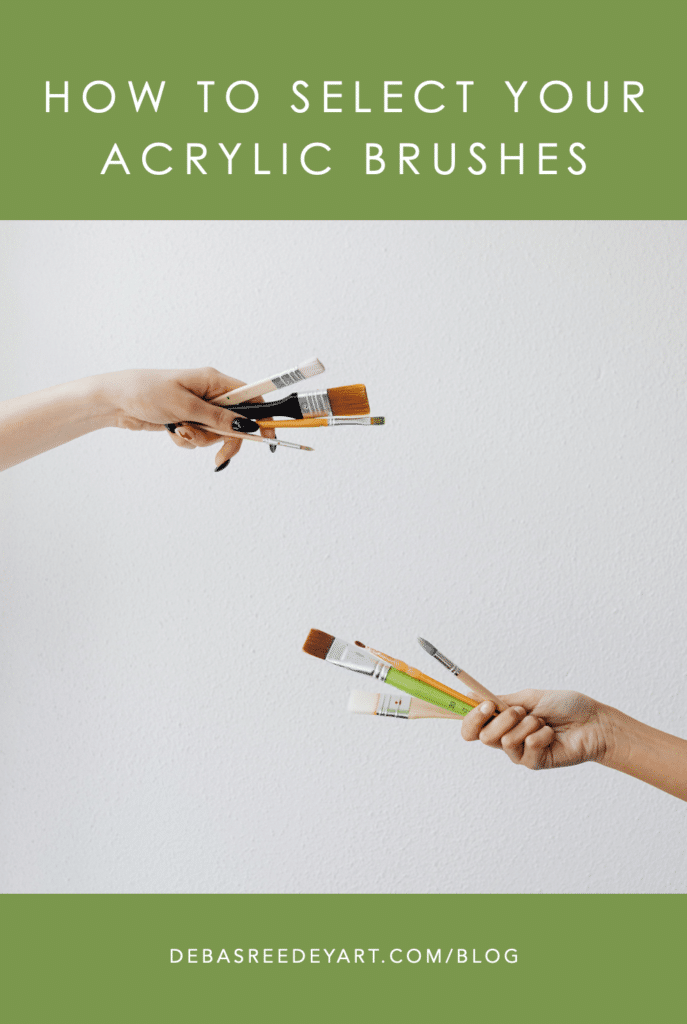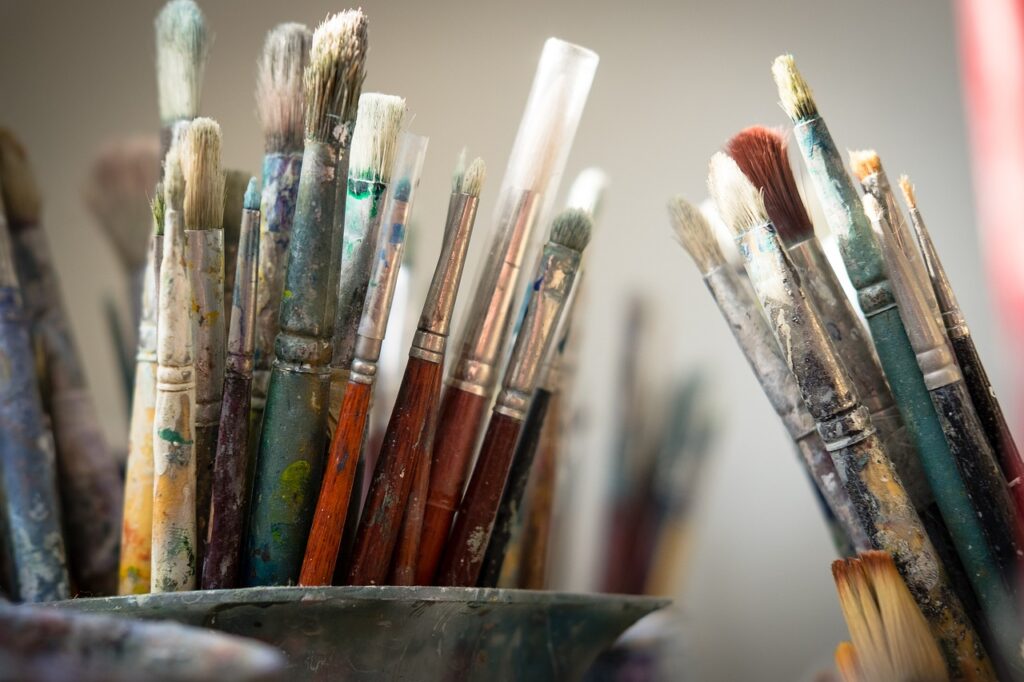Choosing the right acrylic painting brush is essential for achieving desired effects, precision, and overall artistic expression.
With a wide array of options available, selecting the best brush can be overwhelming for beginners and even experienced artists.
In this guide, we will walk you through the key factors to consider when selecting an acrylic painting brush, helping you make informed decisions and enhance your painting experience.

1. Bristle Type
The first consideration when choosing an acrylic painting brush is the bristle type.
There are two main options: synthetic and natural hair bristles.
Each has its own unique characteristics and advantages, catering to different artistic preferences and techniques.
Synthetic Brushes:
Synthetic brushes are made from synthetic materials such as nylon, polyester, or taklon. They have gained popularity among artists, especially for acrylic painting, due to their durability, versatility, and ability to handle the thick consistency of acrylic paints.
Here are some key features and benefits of synthetic brushes:
- Durable: Synthetic brushes are more resilient and durable compared to natural hair brushes. They are less prone to damage, maintain their shape well, and withstand repeated use and cleaning.
- Retain Shape: The synthetic bristles have excellent spring and snap, meaning they bounce back to their original shape after each stroke. This allows for precise control and consistent performance throughout your painting process.
- Absorbency: Synthetic brushes are less absorbent than natural hair brushes, which can be advantageous when working with acrylic paints that dry quickly. They hold the paint on the surface, allowing for better control over blending and layering.
- Versatility: Synthetic brushes are available in a wide range of shapes and sizes, making them suitable for various painting techniques and applications. They are particularly effective for creating smooth, even strokes, blending colors, and adding fine details.
- Animal-Friendly: Synthetic brushes are a great choice for artists who prefer not to use animal-derived products. They offer a cruelty-free alternative to natural hair brushe.
hog hair Brushes:
Hog hair brushes, also known as bristle brushes, are made from the coarse hair of hogs or boars.
They have been widely used by artists for centuries and have distinctive qualities that make them suitable for specific painting techniques.
Here are some characteristics and benefits of hog hair brushes:
- Stiffness: Hog hair bristles are relatively stiff and springy, providing resistance and control during painting. This stiffness allows artists to create bold, textured strokes and work with thicker paints.
- Paint Holding Capacity: Hog hair brushes have excellent paint-holding capacity due to the coarseness of the bristles. They can hold a significant amount of paint, allowing for broader coverage and more expressive brushwork.
- Texture and Impasto: The coarse bristles of hog hair brushes create visible brush marks and texture on the painted surface. They are particularly effective for impasto techniques, where thick layers of paint are applied to create a three-dimensional effect.
- Suitable for Oils and Heavy Bodied Acrylics: Hog hair brushes are often recommended for oil painting due to their stiffness and ability to handle heavy-bodied paints. However, they can also be used with heavy-bodied acrylic paints that mimic the consistency of oils.
- Natural Hair: Hog hair brushes are made from natural animal hair, which is a consideration for artists who prefer using natural materials in their artwork.
2. Brush Shape

Brush shape plays a crucial role in the techniques and effects you can achieve.
Consider the following brush shapes and their applications:
- Flat Brushes: Ideal for covering large areas, creating clean edges, and blending colors.
- Round Brushes: Versatile for detailing, lines, and controlled strokes.
- Filbert Brushes: Combining the benefits of flat and round brushes, they are suitable for blending, softening edges, and creating curved shapes.
- Fan Brushes: Great for creating texture, foliage, and hair-like strokes.
- Angular Brushes: Perfect for precise lines, sharp edges, and angular shapes.
3. Size and Thickness
The size and thickness of a brush are determined by the width of its bristle head.
Consider the scale of your artwork, level of detail desired, and coverage required.
Smaller brushes (such as 0 or 1) are ideal for intricate details, while larger brushes (such as 12 or 24) cover more significant areas with broader strokes.
Having a variety of brush sizes in your collection allows for versatility and flexibility in your painting techniques.
4. Handle Length and Comfort
The handle length and comfort are often overlooked but play a vital role in your painting experience.
Consider the length of the handle based on your preferred working distance from the canvas.
Additionally, choose a brush with a comfortable grip that allows for better control and reduces hand fatigue during long painting sessions.
Test different handle materials, such as wood or acrylic, to find the one that suits your preference.
5. Quality and Brand
Investing in high-quality brushes is crucial for achieving consistent performance and longevity. Reputable brands are known for their craftsmanship, durability, and the use of high-quality materials.
Let us explore the different quality levels of brushes available for acrylic painting, from budget-friendly options to professional-grade tools, helping you make an informed decision when selecting your brushes.
Budget-Friendly Brushes
Budget-friendly brushes are an excellent option for beginners or artists who are experimenting with acrylic painting for the first time.
These brushes are usually made with synthetic bristles, which are more affordable than natural hair bristles.
While they may not offer the same level of precision or durability as higher-quality brushes, they can still serve their purpose and allow you to practice and develop your skills without breaking the bank.
Student-Grade Brushes
Student-grade brushes are designed for artists who have advanced beyond the beginner stage but are still exploring and honing their skills.
These brushes are often a step up from budget-friendly options and offer better performance and durability.
They are usually made with a blend of natural and synthetic bristles, providing a balance between affordability and quality.
Student-grade brushes can handle a variety of painting techniques and are suitable for intermediate-level artists.
Artist-Grade Brushes
Artist-grade brushes are the highest quality brushes available in the market, crafted with meticulous attention to detail and using premium materials.
These brushes are designed for professional artists or serious enthusiasts who demand the best performance and durability from their tools.
Artist-grade brushes are often made with high-quality natural hair bristles, such as sable or Kolinsky, which offer excellent paint-holding capacity, precise control, and superior longevity.
These brushes provide optimal results for advanced techniques, intricate details, and fine art applications.
brush sets
Brush sets are an economical way to acquire a range of brushes, especially if you’re starting out or looking to expand your collection.
They are available in various quality levels, from budget-friendly sets to professional-grade sets.
Brush sets are curated with a selection of brushes suitable for different purposes and techniques, providing versatility and convenience.
While the quality of brushes within sets may vary, they often offer a good starting point and can be supplemented with individual brushes of higher quality as you progress.
6. Consider the Painting Technique
Different painting techniques require specific brush characteristics.
If you enjoy glazing or creating smooth, even layers, opt for brushes with soft bristles that can apply thin layers of paint without disturbing the underlying layers.
For impasto techniques or adding texture, choose stiffer brushes with more resilience that can handle the thickness of heavy-bodied acrylic paints.
7. Start with a Small Collection
If you’re just starting out or on a limited budget, begin with a small collection of essential brushes that cover a range of shapes and sizes.
This allows you to experiment with different techniques and determine which brushes you use most frequently.
As you gain experience and refine your style, you can gradually expand your brush collection to include specialized brushes based on your artistic needs.
Get my exact supply list for acrylic paintings, with helpful color mixing tips that you can start implementing right away!
8. Personal Preference & Experimentation
Lastly, remember that personal preference plays a significant role in selecting the best acrylic painting brush.
Every artist has a unique style and comfort level with different brushes.
Allow yourself to experiment and explore various brush types, shapes, and sizes to discover the ones that resonate with your artistic vision and techniques.
What works for one artist may not work for another, so embrace the journey of finding your perfect brush.
Pin the below image in your Pinterest board for future reference.

Remember, the brush is an extension of your creativity and expression.
While selecting the best acrylic painting brush is important, don’t let it limit your artistic exploration. Be open to trying new brushes, techniques, and unconventional tools that may inspire unique effects and textures in your artworks.
In the end, finding the best acrylic painting brush is a combination of understanding your artistic requirements, experimenting, and refining your preferences over time.
Now, I’d love to hear from you.
What are your favorite brushes for acrylic painting? Do you have any tips or recommendations for selecting the perfect brush? Feel free to share your thoughts and experiences in the comments below.
Happy painting!







